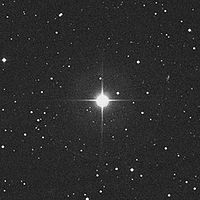Picture Credit Wikipedia
51 Pegasi
Position: 22 hr 57.5 min +20 deg 46 min.
When you see a star mentioned by its Flamsteed number as in the case of 51 Pegasi, you know you are probably dealing with a pretty faint star (not always but nearly always). This is the case with 51 Pegasi which has an apparent magnitude of 5.5 and is best described as yellow-white or yellowish (its spectral type is G2 like our Sun). You would be hard pushed to see it anywhere in Havering, but in one of our darker spot you may be lucky. It is called 51 Pegasi rather than 51 Pegasus because stars take the Latin genitive (“of”) case when a label such as alpha or 1 is attached to it. This is just so astronomers can show off their classical education . To find it, locate the Square of Pegasus (you can easily see it even in Havering) which is currently in the south in the late evening and look (probably with binoculars or the finderscope of a telescope) for a faint star roughly half way between the two right hand stars (Beta and Alpha Pegasi) of the square and off slightly to the right (i.e. to the south). There are two brighter stars (Mu and Lambda Pegasi) above it.
Why is such a minor star our first “star of the month”? We have to thank the Swedish Academy of Sciences who have just awarded the Nobel Prize in Physics to Michel Mayor and his erstwhile PhD student Didier Queloz at the University of Geneva for their discovery of the first exoplanet going round a main-sequence star back in 1995 (and also to the American cosmologist James Peebles). The star was 51 Pegasi and the planet was labelled 51 Pegasi b (using the same nomenclature as double stars where A is the main star, B is the first companion and so on but with lower case letters). The method they used was an obvious one (at least with hindsight), but one which is now rarely used. They used the Doppler effect on the spectral lines of 51 Pegasi to detect a tiny wobble in its motion. This method is used routinely for binary stars, but it was thought that the wobble caused by a planet would be too small to be detected. There was one theoretical exception: a Jupiter-sized planet very close to its parent star. But such an idea was clearly ridiculous, we knew from our own solar system that Jupiters only existed in the ice belt far out and anyway any Jupiter that got that close to its star would evaporate. We now know “hot Jupiters” can exist and are even common. And by a lucky fluke, 51 Pegasi was the very first one with a mass about half that of Jupiter and an orbital period of just over four days.
